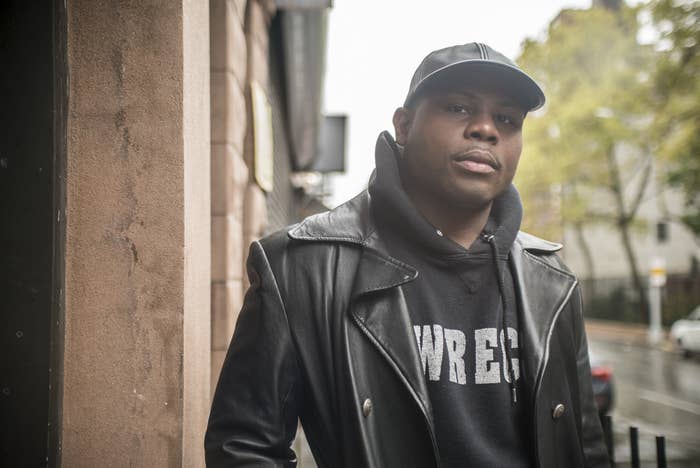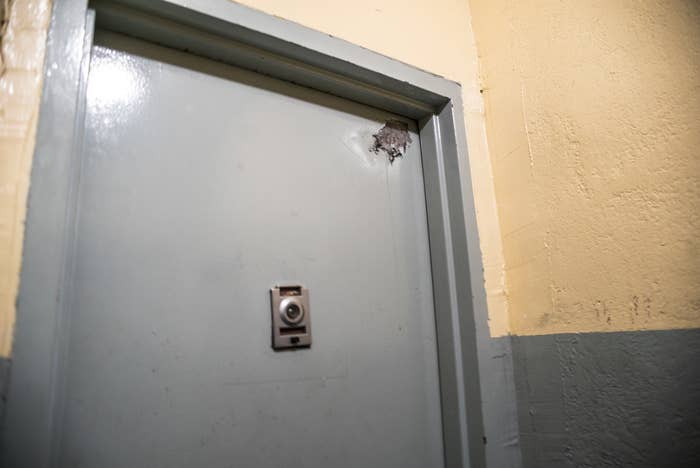
It was 7 a.m. on a warm, overcast Friday in early August, and Derrick Ingram had only been asleep for four hours when he woke up to an incessant pounding on his door.
Ingram, 28, had spent the summer co-organizing one of the most visible Black Lives Matter movements in New York City, Warriors in the Garden, meeting at his apartment, sleeping at each other’s homes after protests, sharing money and resources. They had become a tight little unit. The night before he was rudely awoken by a man knocking loudly at his door, he had finally allowed himself a moment of respite and joy with his newly chosen family.
Thud, thud, thud, the knocking insisted.
“What’s your name?”
“Derrick Ingram,” he replied, the door cracked ajar, thinking he was dealing with an early delivery man.
“Derrick with two R?”
“Yes,” Ingram said.
“I have a warrant for your arrest.”
Ingram immediately snapped out of his sleepy stupor.
His mind started racing: I’m going to jail. I need to do dishes. I haven’t even showered yet.
Little did Ingram know that over the course of the next six hours, the NYPD would show up in front of his apartment with full force. Several police cars blocked off the street where Ingram lived while a helicopter was whirring in the sky, BuzzFeed News reported. More than 30 officers came through the scene over the course of the day.

The NYPD had found an image of Ingram, presumably from social media, and used facial recognition technology to identify him. During the standoff, they started rerouting all his calls to the NYPD using a cellphone spy technology called a stingray, before ultimately jamming the phone and rendering it unusable, Ingram said.
Ingram’s crime? Using a bullhorn to shout at a police officer during a protest.
An NYPD spokesperson described the incident to BuzzFeed News as “an assault on a police officer” during which Ingram placed a bullhorn on the officer’s ear to shout at her, though Ingram told BuzzFeed News that he was at least 6 feet away from the officer and was among other protesters who shouted at the officer, too.
Half a dozen protest organizers like Ingram told BuzzFeed News that they’ve experienced disproportionate force from law enforcement as they took to the streets throughout the summer. Human Rights Watch decried the use of a tactic called “kettling” by the NYPD to entrap demonstrators as “systemic police brutality” and found “several human rights violations” in the way the NYPD handled a Bronx protest on June 4. And, experts say, the police are deploying a full array of surveillance tools to intimidate young protesters.

“The fact that they were willing to use that level of force, all for allegedly using a bullhorn, that really shows how much of the NYPD’s surveillance apparatus is being used to target and punish dissent,” said Albert Fox Cahn, executive director of the Surveillance Technology Oversight Project (S.T.O.P.) and host of the podcast Surveillance and the City.
And the pressure has not let up. Organizers told BuzzFeed News that police have continued to harass and attack protesters, with at least two incidents happening just last week. Five months into the demonstrations and with crowds not nearly as large as they were in the early weeks of the movement, police are still arresting protesters for minor charges like obstructing governmental administration or disorderly conduct. Additionally, organizers told BuzzFeed News they continue to see police officers monitor their meetings.
The New York Post reported the NYPD has been ramping up preparations for Election Day and the force’s Strategic Response Group has been running drills. “We’re hoping for the best this week but we’re prepared for the worst. People have gotten emboldened out there. We’re living through unprecedented times. But we’re prepared for whatever might happen,” Deputy Chief John J. D’Adamo, who helms the Strategic Response Group, told the New York Post.
Now as Election Day looms and the nation braces itself for protests, the tensions between police and protesters will be on full display as movement organizers plan to respond to the election results.
Activists have also become increasingly savvy in countering pressure from the police after learning lessons from this year’s protests.
The day when police decided to surround Ingram’s apartment, his friends advised him to livestream the incident. Hundreds of people tuned in, including celebrities like Alicia Keys. Five hours into the standoff, dozens of protesters came to support Ingram, gathering outside his Midtown apartment and chanting, “Where is the warrant?”
NYPD has left. Still no warrant provided. https://t.co/8m5CucOk8S
By the end of the night, they had achieved what they wanted: The police did not enter his apartment and arrest Ingram. Instead, he led a protest of a hundred people toward the Manhattan precinct where he turned himself in. His charges were reduced to a misdemeanor, and he was freed without bail.
The need for protection
On a breezy September evening, hundreds of people gathered in McCarren Park in Brooklyn for a vigil in honor of Sarah Pitts, a protester and volunteer with Riders4Rights, a group of cyclists in support of the Black Lives Matter movement.
Pitts had been struck and killed by a bus while riding home just a few days prior, and Riders4Rights organizers had decided to honor her life and her involvement with the group during a vigil. The attendees included a long list of friends and organizers who had marched alongside Pitts.
Police were present for the entire evening as bikers and marchers made their way from Fort Greene, Brooklyn, to Williamsburg, a distance that takes about one hour to walk. Once they arrived, attendees spent an hour and a half sharing memories of Pitts, then officers started to form a line, advancing toward the mourners to entrap them and then shoving and beating them with little warning, attendees told BuzzFeed News. NYPD told BuzzFeed News that police had responded “to a group fighting at the location.”
@JoshuaPotash I was there, it's true. On top of that, after blocking people from exiting, they came IN to the park, towards the vigil where candles were still being cleaned up, and escalated into this scuffle: AT A FUNERAL VIGIL
“It was an emotional moment,” said M, an organizer with Riders4Rights who always goes by his first initial to remain anonymous. “All these police were lined up. [...] Then the police makes their way into the park, form a long line, shoulder to shoulder, and they start advancing.”
In videos of the incident, members from Riders4Rights can be heard yelling “De-escalate!” as they tried to prevent police from getting into physical altercations with other protesters.
Riders4Rights was formed early in the protest movement to protect other demonstrators. Responding to reports of NYPD officers pushing, macing, and shoving protesters on the fringes of marching crowds, Riders4Rides would place their bikes between police and people as a barrier. The group has become a bit of an unofficial security provider for other groups who often call upon them for help with their events.
M said Riders4Rights has also had to extend their work to protect people who have been arrested. Aside from their work to register voters and to bring food to those in need, the group has had to allocate more and more funds and manpower to one particular arm of the organization: jail support.
Targeted arrests of demonstrators and organizers based on low-level charges are so frequent now that Riders4Rights have devised several systems to respond and expedite the release of those who are captured. This includes members showing up in front of precincts in shifts to demand the release of their fellow activists.
“The first time someone was arrested, we were not very good at this, but we had to get better over time,” said Nalaé Anais White, 25, an organizer with Riders4Rights. “The better we get at jail support, the more dystopian it feels.”
Twenty-three-year-old Nia was among four protesters who were arrested two weeks ago after she attended a community meetup for another activist group called Abolition Park. After a dinner with fellow volunteers and organizers, the group heard of a large group of police officers gathering outside of a residence.
When Nia proceeded to film the ongoing, police turned toward her, circling her in a swarmlike fashion until she fell over and officers arrested her.
She was charged with obstructing governmental administration, alcoholic beverage public consumption, and disorderly conduct, according to an NYPD spokesperson.
But an attorney coming to the protesters’ defense said authorities could have issued tickets for these offenses instead of placing Nia and her fellow protesters into jail for more than 30 hours.
“The NYPD are charging people with a whole lot of things just to give them a record,” Nia told BuzzFeed News. “I expect the worst of them.”
An increasingly partisan conflict
These arrests are particularly egregious to organizers in the movement because other more violent demonstrations organized by conservative groups did not result in arrests. The same night Nia was arrested, ultra-Orthodox Jewish protesters were attacking journalists and perceived dissenters, Gothamist reported. But the NYPD did not interfere with those protests, Gothamist reported. Similarly, in early September a car of conservative counterprotesters drove through a crowd of Black Lives Matter supporters in Times Square, and they were never charged with a crime.
“From the beginning, the question has been who do they protect?” M told BuzzFeed News. “You’re supposed to protect and serve New Yorkers. Here are 3,000 New Yorkers protesting. Where do you get off meeting us with violence, when we’re literally the community you’re supposed to protect?”
This seemingly lopsided way of enforcing the law is indicative of a trend that protesters and advocates alike have observed on the ground: an openly political leaning toward President Donald Trump. The union that represents tens of thousands of New York City police officers endorsed Trump in mid-August. A New York City cop was recently suspended after he repeatedly said “Trump 2020” through his patrol car speakers. And several organizers told BuzzFeed News they’ve seen police wear masks that support Trump.
“The NYPD’s ties to Trump are uncomfortable,” said Ingram.
Ingram is worried about what the days following the election will look like. But he and his fellow organizers still plan to march to the polls and cheer people on as they cast their ballot.
On Tuesday, the group hopes to have a viewing party of the results. Regardless of who wins, he wants to be surrounded by the people he loves, his newfound family, he said.
